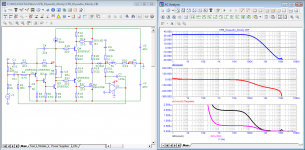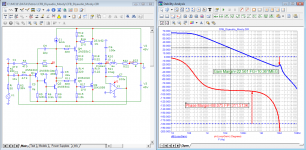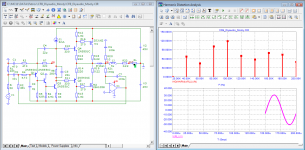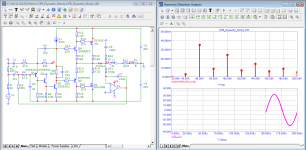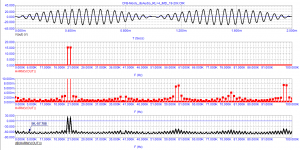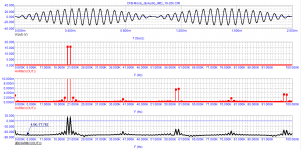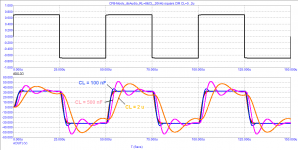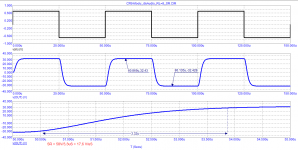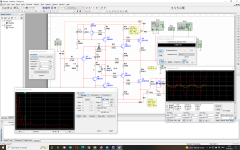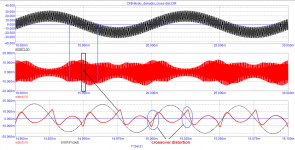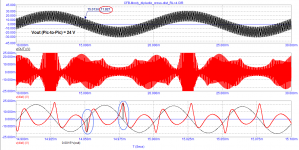The scope shots all look good 👍
(I can delete that second 50kHz image)
Yes Mooly do it : there is no need of twice an image.
Thank you.
Best regards
rephil
""I have got a problem with the output 10Ohm 3W (in the Zoble) that I had : it burned at once when I did put the amp on. There is no explanation for me, as there was not any oscillation to be seen on the scope. A bad 10Ohm 3W ? A fake ? After putting another 10Ohm 5W in the Zoble, all went OK, no damage at all else than the 10Ohm 3W.""
Hi rephil,i can imagine only one reason for this.
Amplifier oscillates at very high frequency.
What is the input condition in this case?
Open,shorted,connected at generator?
Is the input gnd loosen?
Hi Thimios
I see no way to get an answer to this. Floating wires could have been not well connected. As you see on the scope pictures I did provide: there is not any oscillation to be seen in the trace. They don't fatten even a little. The scope is a Tektronix 2245A, 100MHz. A so nasty problem like this one that appears at once at the moment you switch on the power amp ? I can't believe in problems of oscillation that were not present to be seen before on the scope even a very small bit. Before the crash, I have got exactly the same figures reported here as you can see after having changed the 10Ohm 3W with a 10Ohm 5W that I had here home. This change was only done not to use the same kind of 10Ohm I did use before.
The scope was on and connected to the output of the amp, the generator (Agilent) was connected and provided a fixed distorted trace on the scope, this distorted trace did not change changing from sine to triangular on the generator.
I did connect (solder) the writing I/P pad located at the right of the PCB where is located the input connector to the principal GND on the PCB with a wire under the PCB.
I have no other information about that problem.
Thank you my friend. Have a nice end of the day.
Best regards
rephil
Sorry,are we speaking for the 10R in series with 100nf,zobel resistor?
If yes,i can't see any other reason for a smoking resistor.
Always that i have a smoking zobel is because i push the amplifier hard with a high level-high frequency square wave input signal or when amplifier oscillate by themselve.
If yes,i can't see any other reason for a smoking resistor.
Always that i have a smoking zobel is because i push the amplifier hard with a high level-high frequency square wave input signal or when amplifier oscillate by themselve.
Last edited:
Hi ThimiosSorry,are we speaking for the 10R in series with 100nf,zobel resistor?
If yes,i can't see any other reason for a smoking resistor.
Always that i have a smoking zobel is because i push the amplifier hard with a high level-high frequency square wave input signal or when amplifier oscillate by themselve.
Yes it is the 10Ohm in the Zobel. I did not push the amplifier at all using at the input always 50mVpp signals and there was no load attached to the amp. Other tests are to be done later with a load attached, and then in my lab with the speakers I have for the tests. The amp has been built the most possible using the same valued components as written by Mooly in the schematic. The yellow 150pF at the input is exactly 150pF, I did measure it. It is a Wima FKC 2, polycarbonate. So it will not let come inside very high frequencies. All values have been soldered having the best nearer value I had to put in each place. Both PCBs have the same component values. This means that the two channels will work the same.
Thank you for your interest.
Best regards
rephil
I don’t understand how an amplifier with such parameters can be suitable for sound
Attachments
Underutilization of the supply voltage of at least 15 V from each bus.
The level of distortion products in the audio band is up to -58 dB. Good amplifiers are at least 60 dB better (-120 dB or less).
The slew rate of the output voltage according to Bob Cordell must be at least 50 V / µs. John Curl has more stringent requirements: at least 100 V / μs.
Run a David Hafler SWDT test at 10 kHz and show the result.
The effectiveness of this test was proved by Bob Carver with his experiment. It is useful to know and use this test at least virtually before taking on a soldering iron.
The level of distortion products in the audio band is up to -58 dB. Good amplifiers are at least 60 dB better (-120 dB or less).
The slew rate of the output voltage according to Bob Cordell must be at least 50 V / µs. John Curl has more stringent requirements: at least 100 V / μs.
Run a David Hafler SWDT test at 10 kHz and show the result.
The effectiveness of this test was proved by Bob Carver with his experiment. It is useful to know and use this test at least virtually before taking on a soldering iron.
Attachments
I'm looking... and thanks for the interest 🙂
Totally unrelated but this got me chasing an anomaly in the simulations, perhaps a carry over from LTIV to LTXVII. Long story short, the distortion was coming out at nearly 1% and I couldn't see why. The longer the sim runs and the worse it gets... so timestep setting perhaps. The reason seemed to be that LTXVII will only accept the timestep entering onto the sim in a certain way. You can not copy and paste the timestep required which I'm sure you always could in the past.
Anyhow...
Last shot is at the point of clipping. The single die FET's are the limit here and that is well known and down to the high on resistance of laterals. My sim gets a lot closer to the rails than does yours apparently. The real build may well get as close or closer still.
Whatever you might think of the technical aspects of the amp, the design brief was for an an amp that sounded great to listen to and the fact its still in daily use suggests that goal has been met. It was never intended to be a laboratory amp.
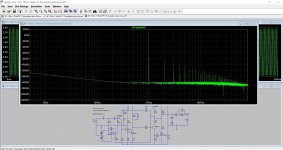
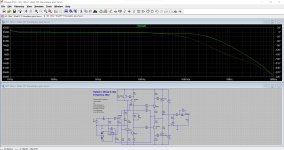
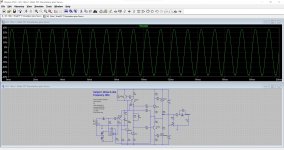
Totally unrelated but this got me chasing an anomaly in the simulations, perhaps a carry over from LTIV to LTXVII. Long story short, the distortion was coming out at nearly 1% and I couldn't see why. The longer the sim runs and the worse it gets... so timestep setting perhaps. The reason seemed to be that LTXVII will only accept the timestep entering onto the sim in a certain way. You can not copy and paste the timestep required which I'm sure you always could in the past.
Anyhow...
Last shot is at the point of clipping. The single die FET's are the limit here and that is well known and down to the high on resistance of laterals. My sim gets a lot closer to the rails than does yours apparently. The real build may well get as close or closer still.
Whatever you might think of the technical aspects of the amp, the design brief was for an an amp that sounded great to listen to and the fact its still in daily use suggests that goal has been met. It was never intended to be a laboratory amp.



I'm looking... and thanks for the interest 🙂
Totally unrelated but this got me chasing an anomaly in the simulations, perhaps a carry over from LTIV to LTXVII. Long story short, the distortion was coming out at nearly 1% and I couldn't see why. The longer the sim runs and the worse it gets... so timestep setting perhaps. The reason seemed to be that LTXVII will only accept the timestep entering onto the sim in a certain way. You can not copy and paste the timestep required which I'm sure you always could in the past.
Anyhow...
Last shot is at the point of clipping. The single die FET's are the limit here and that is well known and down to the high on resistance of laterals. My sim gets a lot closer to the rails than does yours apparently. The real build may well get as close or closer still.
Whatever you might think of the technical aspects of the amp, the design brief was for an an amp that sounded great to listen to and the fact its still in daily use suggests that goal has been met. It was never intended to be a laboratory amp.
View attachment 1067058
View attachment 1067059
View attachment 1067060
Hi Mooly
Yes, I totally agree with you : I want an amp that sound great with classical music, and not one that is measuring very good. I have already built some of these very good measuring amp. I have built a few SymAsym and a few Honey Badger. I have also bought in the years many power amp that did not satisfy me very much (Revox, several Nad, Rotel). They sound all very good, but after hearing the music for a bit, I switch down the amp as it makes me tired. It was not what I wanted. So here I am with a big hope.
First question : in your third simulation, I see that the trace is going up in the negative part of the sine. I have that also but only in the positive part of the sine, this being only at above 81W when using an 8 Ohm dummy load. At lower Watt values, there is nothing weird like that to be seen. What I get is what I have presented here without any load. All is perfect, and even using the 8Ohm dummy load, the rectangular shape at 20kHz the amp providing around 20W was totally OK, this was a very fast try obviously ... Why is there such thing in the trace of the sine ? Well, this is not an existential question ... I will never use so many Watts. A few Watts are all is needed for people that want to enjoy home good classical music.
Second question : I use a diy power supply with very high value of capacitors (it is ready to use on my bench, not the one I will build for the amp) with on each rail around 50mF, it is much. My question is : the voltage takes time to get down to zero after switching off the amp. Is there an expected problem in switching the amp on without letting the supply to go down ? I have not yet the answer about why the 10Ohm 3W did burn in the Zobel. The 10Ohm 5W is not even warm ...
Thank you for your answer Mooly.
Get a nice day enjoying good music Mooly.
Best regards
rephil
Yes, I totally agree with you : I want an amp that sound great with classical music, and not one that is measuring very good. I have already built some of these very good measuring amp. I have built a few SymAsym and a few Honey Badger. I have also bought in the years many power amp that did not satisfy me very much (Revox, several Nad, Rotel). They sound all very good, but after hearing the music for a bit, I switch down the amp as it makes me tired. It was not what I wanted. So here I am with a big hope.
It will not disappoint. What you mention is exactly what I used to find.
and not one that is measuring very good.
This one is pretty good...
This is at 1 watt and 80 watts into 8 ohm.
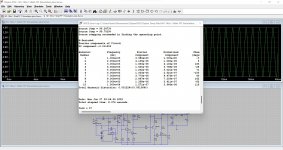
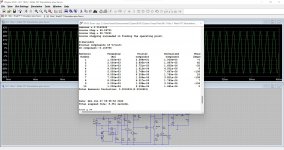
Second question first...
Is there an expected problem in switching the amp on without letting the supply to go down ? I have not yet the answer about why the 10Ohm 3W did burn in the Zobel. The 10Ohm 5W is not even warm ...
As mentioned a few times in the thread, the circuit needs a good and reliable speaker delay circuit. This is one that gives around 6 seconds delay at power on and one that disconnects the speakers quickly on power off and ideally gives the full 6 second delay even after a brief on/off cycle. I think I used Doug Selfs circuitry from the Precision Preamp from the mid 1990's (its all a long time ago 😉) as that fitted the bill exactly. Providing this requirement is met then you can cycle the amp on and off as quickly as you like. Delays are easy to implement, instant off less so but having said that if the rails fall slowly (which they will) then its still easy to make a circuit that drops out quicker than the rails fall.
First question : in your third simulation, I see that the trace is going up in the negative part of the sine. I have that also but only in the positive part of the sine, this being only at above 81W when using an 8 Ohm dummy load.
It is just the normal clipping behaviour. I didn't add extra circuitry to limit any 'bad behaviour' under those conditions because it should not ever come close to operating in that region. The VAS current increases dramatically at clipping (not destructively, just a big increase over normal) as current is pulled to and fro through the driver transistor B-E junctions. I considered running at the limit of clipping to not really be a valid state.
In another simulator, the amplifier parameters are slightly better and do not change with long -term testing.
Rephil, maybe you need to change the acoustic system?
The resistor in the Zobel may burn due to the fact that the amplifier is excited at a high frequency.
Rephil, maybe you need to change the acoustic system?
The resistor in the Zobel may burn due to the fact that the amplifier is excited at a high frequency.
Attachments
Low speed leads to the fact that the amplifier can not cope with switching distortion. Their level is even higher than the level of non-linear distortion. Therefore, in the spectrum of a 20 kHz signal, we see a wide range of distortion products.
From an audiophile's point of view, over 99.9% of all manufactured and homemade amplifiers do not meet the requirements of high quality sound amplification. Nevertheless, all these amplifiers are listening.
From an audiophile's point of view, over 99.9% of all manufactured and homemade amplifiers do not meet the requirements of high quality sound amplification. Nevertheless, all these amplifiers are listening.
Attachments
In another simulator, the amplifier parameters are slightly better and do not change with long -term testing.
Rephil, maybe you need to change the acoustic system?
The resistor in the Zobel may burn due to the fact that the amplifier is excited at a high frequency.
Hi Yurik_V
I did not connect any acoustic system to the amp for now. The fact that I am not very satisfied with what I have home is only a reality, but I can live without problem with all as is. I have here good big speakers from Canton. The place where they are placed is big enough in order to get good bass (4m x 7m). The amp is connected to a good Denon SACD.
Yes, I know that the Zobel resistor may burn when excited at high frequencies, but there was nothing connected to the output and the amp is stable (oscillations can be seen on the scope).
You know, for now they are many people that are in need of help, I prefer to help them instead of spending money for changing in better what I have already good here. Recently for the first time in all my live, different people did bell at my door because they needed food for their small children. Even a woman did bell home one sunday that needed to get powder milk for her very small child ! I find this situation unacceptable for a lot of poor people. They don't even ask for money ! So, I prefer to help people when I am able to do it as I am a christian.
Thank you for your interest Yuri_V.
Best regards
rephil
It will not disappoint. What you mention is exactly what I used to find.
This one is pretty good...
This is at 1 watt and 80 watts into 8 ohm.
View attachment 1067089
View attachment 1067090
Second question first...
As mentioned a few times in the thread, the circuit needs a good and reliable speaker delay circuit. This is one that gives around 6 seconds delay at power on and one that disconnects the speakers quickly on power off and ideally gives the full 6 second delay even after a brief on/off cycle. I think I used Doug Selfs circuitry from the Precision Preamp from the mid 1990's (its all a long time ago 😉) as that fitted the bill exactly. Providing this requirement is met then you can cycle the amp on and off as quickly as you like. Delays are easy to implement, instant off less so but having said that if the rails fall slowly (which they will) then its still easy to make a circuit that drops out quicker than the rails fall.
It is just the normal clipping behaviour. I didn't add extra circuitry to limit any 'bad behaviour' under those conditions because it should not ever come close to operating in that region. The VAS current increases dramatically at clipping (not destructively, just a big increase over normal) as current is pulled to and fro through the driver transistor B-E junctions. I considered running at the limit of clipping to not really be a valid state.
Hi Mooly
Thank you for your answers Mooly.
I always use a speaker delay at power on and that disconnect quickly on power off. I will see later to provide the 6 seconds needed, there is a way to get a longer delay as the 2-3 seconds it provides for now with the circuit I have ready here.
The normal clipping behaviour is OK thus. Thank you.
Today I did attach the first and only tested channel placed on an heatsink 100mmx160mmx40mm (0.7°C/W) this using a self done variable resistor (10kOhm), this is done using a rotary switch 4P24T without any preamp connected. I will put that preamp later on when I will proceed with the self made PCB needed I have to produce home. All is already ready for this. The speakers are Pioneer Prologue 70 for testing pourpose in my lab. They are outstanding, and I did buy them second hand for little money ... From time to time good stuff can be found second hand for mostly little money !
The first results are very good, no sound at all to be heard without a CD bringing some music to the amp. It is dead silent.
I believe that you have done exactly what I wanted to get. Now I am hearing the right channel of Schubert "An die Music", piano is OK, the voice of Elly Amelinck is very nice, even using only one channel ... It will be better and more natural when I will have soldered the power transistors to the second PCB and connected all to your power amp. It is all what I have to solder there. At first, I will check if there are problem with the 10Ohm 3W in the Zobel that is already soldered there obviously !
Next was the Oboe Concertos from Domenico Cimarosa, a cheap CD from Deutsche Grammophon. What a pleasure to hear that ! At the Oboe was Heinz Holliger. Live seems to me better now !
I did hear also the 4ème sonate pour clavecin, arranged for the harp by H. Renié from Domenico Paradisi, at the harp is Naoko Yoshino, a CD from Philips. She is a great harpist indeed. What a pleasure with this amp and only one channel working ... Your amp promise really much Mooly, and I will report later what I think when I have it good working and placed in a chassis I have here home. The heatsink I will use in the chassis is a bigger sized one, this heatsink of 0.7°C/W is warm not hot after hearing one hour of good music, but the face is placed down to the bench, the fins not vertical as it should be. Be patient please, I am very slow in producing what is needed, it will take many monthes !
Now it is time to solder the power transistors, and next to drill another 0.7°C/W heatsink for placing the second channel ... These heatsinks in my lab have already a lot of drilled holes, but not those I need !
This kind of amp you did will end long after my life for sure !
Thank you for this amp designed for music Mooly.
Have a nice day.
Best regards
rephil
Glad to see another working amplifier!
Finally the most important....enjoy the Music!
thimios
Finally the most important....enjoy the Music!
thimios
And thanks for the kind words 🙂Thank you for your answers Mooly.
The 6 second delay is about the time needed for an essentially silent connect of the speaker, if you use a shorter delay you will hear a slight thump as the speaker connects. This shows the first couple of seconds and it might look like that is all that is needed but for a truly silent connect you need to delay for longer. The reason for this is the settling time of the servo which is used to provide the required bias voltage for the amplifier input.
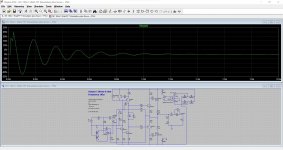
Hi Mooly
The second channel is tested. The 10 Ohm 3W in the Zobel in this second channel does not show any problem. So, the only thing that remains for the burning of this resistor in the first channel is what you did say : some mess with the connections.
The offset is around -0.3mV using a TL071CP. This new second channel has like the first a BW of 170kHz (at that frequency the attenuation of the output is -3dB down compared with the amplitude of the output at 1kHz). There is not any trace of instability or fattening of the trace on the scope. Thus no oscillation can be seen : good news as it is not at all an oscillator but a power amp.
The sine, triangular and rectangular shape on the scope are the same as the first channel when connected to the 8 Ohm dummy load. No problem there.
Tomorrow will be the day I will connect the second speaker to the second channel (the left this time)! Later I will report my impressions after having taken the time to enjoy some music in my lab.
Mooly, thank you for your answer about the delay time needed in order not to be disturbed by the thumb it will provide at power on.
Best regards
rephil
The second channel is tested. The 10 Ohm 3W in the Zobel in this second channel does not show any problem. So, the only thing that remains for the burning of this resistor in the first channel is what you did say : some mess with the connections.
The offset is around -0.3mV using a TL071CP. This new second channel has like the first a BW of 170kHz (at that frequency the attenuation of the output is -3dB down compared with the amplitude of the output at 1kHz). There is not any trace of instability or fattening of the trace on the scope. Thus no oscillation can be seen : good news as it is not at all an oscillator but a power amp.
The sine, triangular and rectangular shape on the scope are the same as the first channel when connected to the 8 Ohm dummy load. No problem there.
Tomorrow will be the day I will connect the second speaker to the second channel (the left this time)! Later I will report my impressions after having taken the time to enjoy some music in my lab.
Mooly, thank you for your answer about the delay time needed in order not to be disturbed by the thumb it will provide at power on.
Best regards
rephil
Hi Mooly
I have already heared for a few hours in my lab how your power amp do sound. Great is the word that comes at once to my mind. It is very clean, and for the first time I find that what are not acceptable are my Pioneer Prologue 70... That never occured before with all the power amp I did build !
The piano in the third concert for piano and orchestra from Prokofiev sounds great, at the piano was Anna Vinnitskaya the winner of the "Concours Reine Élisabeth" in 2007. The stereo effect is wonderful, the piano sounds like it should being deep when it should be, cristal clear when it should be, very detailed sound indeed ! I am so grateful for this Mooly !
Now I am listening to the huit préludes from "L'art de toucher le Clavecin" (François Couperin) with Blandine Rannou at the harpsichord. What a joy to listen to such beautiful works, so good presented by your amplifier. Many, many thanks Mooly to have provides us with such a nice amplifier designed for music. It is exactly what you say and what I have now in my lab !
Now, I will have to finish the job ... Soldering a new power supply with smaller values of capacity, drill holes in the new chassis I have here (a dissipante 3U/400mm, 4mm), and to produce a preamp for the power amp (well, a follower using some op amp I have here (probably an OPA2134 or an LM4562). I would be grateful to have your opinion for the choice of the opamp. I have also others op amp at home.
Again many thanks Mooly for this wonderful sounding power amp.
Many thanks also @prasi for the so good PCB that he provided to all of us. It was easy to work, it is very well done and provides good sounds without any problem.
Best regards
rephil
I have already heared for a few hours in my lab how your power amp do sound. Great is the word that comes at once to my mind. It is very clean, and for the first time I find that what are not acceptable are my Pioneer Prologue 70... That never occured before with all the power amp I did build !
The piano in the third concert for piano and orchestra from Prokofiev sounds great, at the piano was Anna Vinnitskaya the winner of the "Concours Reine Élisabeth" in 2007. The stereo effect is wonderful, the piano sounds like it should being deep when it should be, cristal clear when it should be, very detailed sound indeed ! I am so grateful for this Mooly !
Now I am listening to the huit préludes from "L'art de toucher le Clavecin" (François Couperin) with Blandine Rannou at the harpsichord. What a joy to listen to such beautiful works, so good presented by your amplifier. Many, many thanks Mooly to have provides us with such a nice amplifier designed for music. It is exactly what you say and what I have now in my lab !
Now, I will have to finish the job ... Soldering a new power supply with smaller values of capacity, drill holes in the new chassis I have here (a dissipante 3U/400mm, 4mm), and to produce a preamp for the power amp (well, a follower using some op amp I have here (probably an OPA2134 or an LM4562). I would be grateful to have your opinion for the choice of the opamp. I have also others op amp at home.
Again many thanks Mooly for this wonderful sounding power amp.
Many thanks also @prasi for the so good PCB that he provided to all of us. It was easy to work, it is very well done and provides good sounds without any problem.
Best regards
rephil
That's great news 🙂 I'm really pleased it is all working well and you like what you hear. The preamp section of my amp uses the LM4562 (make sure you get genuine ones) which are probably about as good as it gets for straightforward gain stages.
That's great news 🙂 I'm really pleased it is all working well and you like what you hear. The preamp section of my amp uses the LM4562 (make sure you get genuine ones) which are probably about as good as it gets for straightforward gain stages.
Hi Mooly
Thank you for saying that you use the LM4562 in your peamp section. I will use it too. Those that are in my lab are the good genuines ones, I don't appreciate to buy fakes, cheaper when you pay them, and much more expensive when you use them and after you have to change them or even change also more others components in order to have a good working circuit.
I have continued to evaluate your power amp hearing some other CDs I have home.
Here it is :
The trumpet concerto in E flat major from Joseph Haydn, a CD from Delos with Gerard Schwarz at the trumpet and conductor. It is very difficult to hear a trumpet with a sound like a true trumpet. Your amp did it : a sweet sounding trumpet even in the high and all its register. Wonderful !
Next was the Macdowell concertos 1 and 2 for piano and orchestra. You should hear at the end of the CD the Witches' Dance op17 No2 ! This all is great at least. The CD is from Naxos American Classics.
Next was some human voices in the CD La Nemica D'Amore Fatta Amante ( Giovanni Bononcini ) it is a CD from Ensemble 415. The voices are so beautiful with your amp !
After that I put some J.S.Bach Organ Chorales. The CD is from Erato with Marie-Claire Alain at the organ. Perfect sound of the organ, and don't speak of the interpret that is also wondefully playing.
And what should I say of the so nice sounds coming from the next CD from Naxos : John Dowland, Dowland's Tears ... You did reach the perfection there Mooly with this nice power amp !
The last for this time is the "Symphonies pour les soupers du Roy" from Michel-Richard Delalande ... A CD from Harmonia Mundi. In the "Concert de Trompettes" first track, a Rondeau, you hear the drums sounding ... It lacks only to meet the King of France to get full pleasure ! The drums sound strong and the right way ! Again perfection is reached !
To be clear, I know that the truth is clear to your eyes when you drink some good wine as did say the ancient : "in vinum veritas" did they say. I did not drink some wine before listening to good
music, it was not necessary to get the real truth, but now, I could drink some glass of wine 🍷
 🍷 at your health Mooly !
🍷 at your health Mooly !Thank you for this nice power amp so good sounding, even with my only good and far from being perfect speakers in my lab.
Best regards
rephil
- Home
- Amplifiers
- Solid State
- My MOSFET amplifier designed for music
